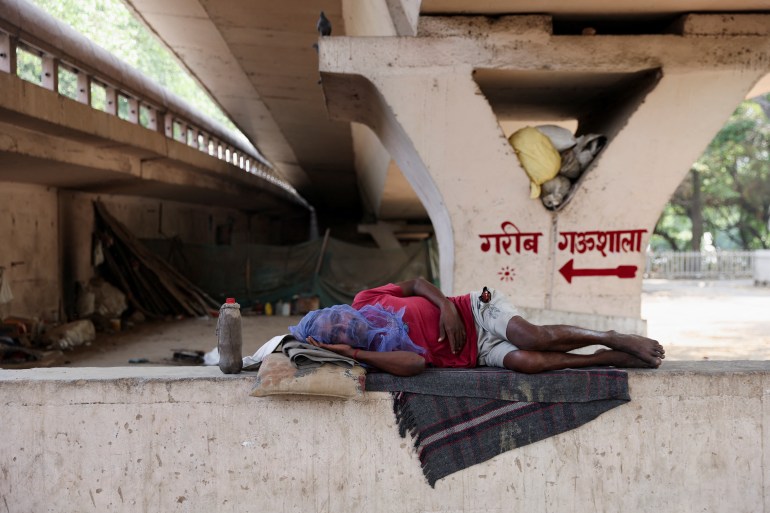India’s heatwave exposes divide in access to cooling equipment
Almost 323 million Indians at high risk from extreme heat amid lack of access to fans and refrigerators, report released last week finds.

As the scorching sun beat down on his fruit cart, Mohammad Ikrar dreaded another day of tossing out dozens of rotting mangoes and melons – a regular practice as India grappled with an unprecedented heatwave this month.
The 38-year-old does not own a refrigerator, meaning his fruit quickly spoils. By the end of the day, any leftover produce is usually only good to be fed to passing stray cows.
Keep reading
list of 4 itemsDehydrated birds falling from sky in India amid record heatwave
‘Hottest summer ever’: Many Indian states under ‘severe’ heatwave
How much is climate change to blame for heatwaves in South Asia?
Since April, Ikrar said he has lost up to 3,000 rupees ($39) a week – nearly half of his average weekly earnings.
“This heat is torturous. But if I want to buy an AC (air conditioner) or fridge one day, I have to do this,” said Ikrar, wearing a full sleeve shirt and white headwrap to keep cool in the 44 degrees Celsius (111.2F) heat.
Heavy rain and thunderstorms in the New Delhi area early on Monday brought the scorching temperatures down to about 20C, with Mahesh Palawat, vice president of Skymet, a private weather forecasting agency saying in a social media post that the heatwave would not come back “anytime soon” in the region.
But temperatures are set to soar again to about 40C later in the week, according to India’s weather office.
Monday’s storm knocked out power in large parts of the capital city – a problem Ikrar has become accustomed to this summer.
At home, he and his family suffer hours-long power cuts day and night, rendering the ceiling fan useless in their one-room house in Noida, a satellite city of New Delhi.
He sends all three of his children to a school fitted with air coolers for “respite” from the heat.
“I sweat all day, then sweat all night. There is no way to properly cool off. I haven’t experienced anything like this since I moved here eight years ago,” he said.
Ikrar provides a snapshot of the threat Indians face from a lack of access to cooling amid widespread blackouts.
Almost 323 million people across the country are at high risk from extreme heat and a lack of cooling equipment such as fans and refrigerators, found a report released last week by Sustainable Energy for All (SE4ALL), a UN-backed organisation.

India topped a list of “critical” countries, also including China, Indonesia and Pakistan, which have the largest populations facing heat-related dangers ranging from immediate deaths from overheating to impacts on food security and incomes.
Temperatures in the New Delhi area soared above 49C (120F) in some regions in mid-May after India recorded its hottest March in 122 years and an unusually hot April.
Temperatures are expected to cool as monsoon rains arrive in June.
‘Worrying urban trends’
India’s electricity demand has hit a record high with a surge in the use of air conditioning triggering the worst power crisis in more than six years.
But, like Ikrar, not everyone can beat the heat.
Although nearly all households in India have access to electricity, only a fraction of its 1.4-billion population owns any cooling appliances, found SE4ALL.

As demand for cooling will soar in coming years, it will also add pressure to India’s over-stretched electricity systems and lead to a potential increase in planet-warming emissions, said Brian Dean, head of energy efficiency and cooling at SE4ALL.
“(This) in turn further exacerbates the risk of longer and more extreme heatwaves,” he told the Thomson Reuters Foundation.
He urged authorities to quickly implement the India Cooling Action Plan (PDF), launched in 2019, which aims to cut cooling demand by up to 25 percent by 2038 through measures including developing new cooling technology and designing buildings with natural airflow.
Scientists have linked the early onset of an intense summer to climate change, and said more than a billion people in India and neighbouring Pakistan were in some way at risk from the extreme heat.
Indian government data shows at least 25 people have died from heat stroke since late March, the highest toll in the past five years.
The official number is just “the tip of the iceberg”, said Dileep Mavalankar, head of the Indian Institute of Public Health, a private university in Gandhinagar in the western state of Gujarat.

Heat is a largely invisible killer which can be hard to pinpoint as a cause of death, he said, especially as it often affects elderly and unwell people and can be caused by indirect exposure such as being trapped in small, poorly ventilated homes.
Such indirect exposure cases make up about nine in 10 heat deaths, he said, with India likely counting only about 10 percent of the true total.
Mavalankar helped implement South Asia’s first Heat Action Plan (HAP) in Ahmedabad in Gujarat in 2013, after the city saw more than 1,300 deaths in a 2010 heatwave. He credited the HAP for saving up to 1,200 lives every summer.
The HAP, which includes early warning text messages to mobile phones, has expanded to nearly two dozen heatwave-prone states and more than 130 cities and districts.
The plan also directs people to seek respite from heatwaves in “cooling centres” such as air-conditioned public buildings, shops and malls, temples and parks. For some, they can be life-saving.
Mavalankar and SE4ALL’s Dean both called for the broader use of “cool roofs” with reflective surfaces or coatings to reduce temperatures in low-income and informal housing.
From building heat-resistant homes to creating more green spaces, Mavalankar said prompt action is needed to help the poor and vulnerable survive a hotter world.
“Temperatures may increase by three to five degrees in coming summers,” he warned. “We have to prepare right now.”